Pinterest is a powerful channel for content distribution. To get the most out of your Pinterest marketing strategy, you need to track your success using Pinterest analytics.
Pinterest metrics like Pin clicks, impressions, and saves pinpoint how your Pins are performing. When you know how to read your data to its full potential, those analytics keep your Pinterest business strategy sharp.
Whether you’re a Pinterest beginner or a Pinning pro, our Pinterest analytics guide can help you make sense of the data. Read on to learn how to read Pinterest analytics, including which metrics to track, what they mean, and which social media analytics tools can help.
Bonus: Download your free pack of 5 customizable Pinterest templates now. Save time and easily promote your brand with professional designs.
How to check your Pinterest analytics
First, make sure you’ve got a Business Pinterest account. Not sure how? Follow these simple steps to make your Business account, then return here.
There are a few ways to check Pinterest analytics: desktop, mobile, or with a third-party social media tool like Hootsuite Analytics.
Let’s go over how to track your analytics using each method.
How to access Pinterest analytics on desktop
1. Log in to your Pinterest business account
2. Click Analytics in the top left corner to show the drop-down menu
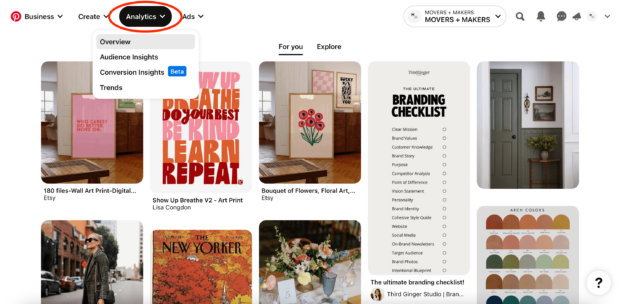
3. Select Overview to see the recent organic and paid performance of your Pins and boards. You can also filter your metrics by a certain date range or content type.
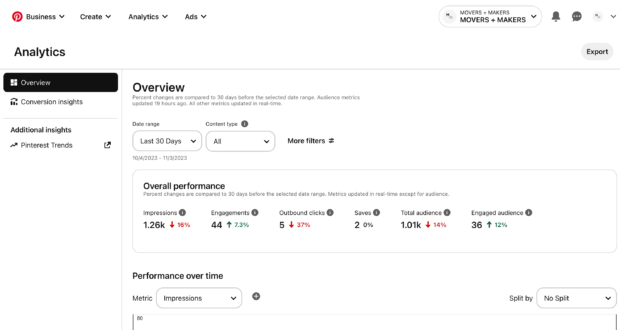
4. To navigate to the other analytics from the drop-down menu, simply click on Analytics and select:
- Audience Insights for follower analytics
- Conversion Insights to track paid campaigns
- Trends to see what’s popular on Pinterest
How to access Pinterest analytics on mobile
1. Open the Pinterest app. (Again, you must have a Business profile set up to access Pinterest analytics on mobile).
2. Tap your profile photo in the bottom right
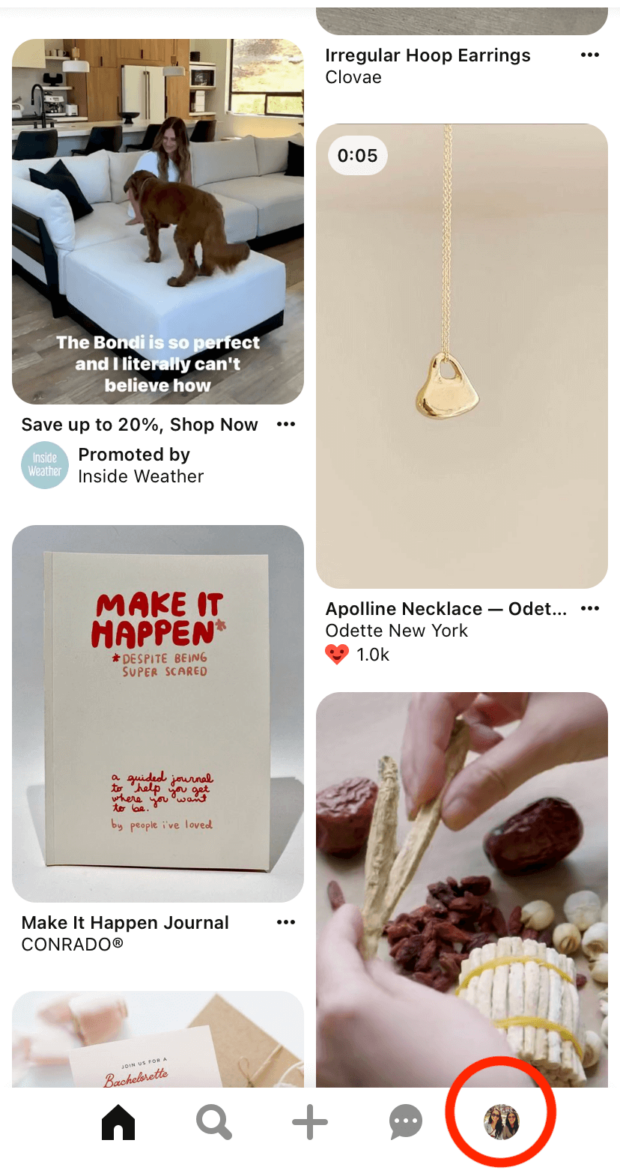
3. In the top left corner, you’ll see an analytics icon. Tap the icon to access your Analytics and Audience insights.
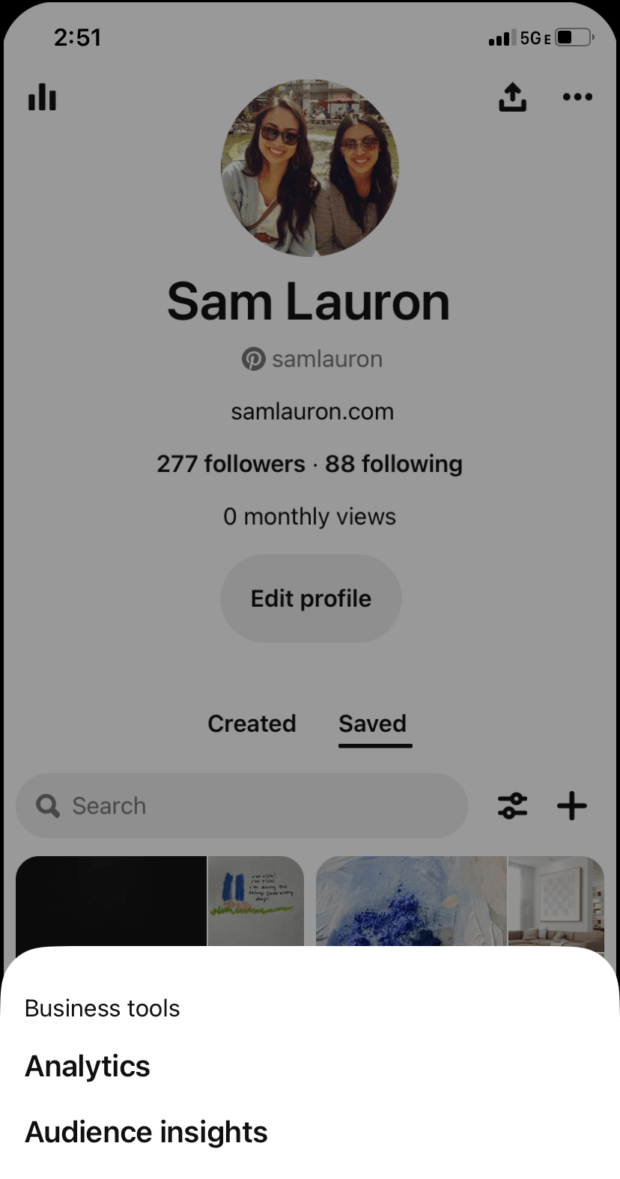
4. Tap Analytics to see an overview of your recent performance.
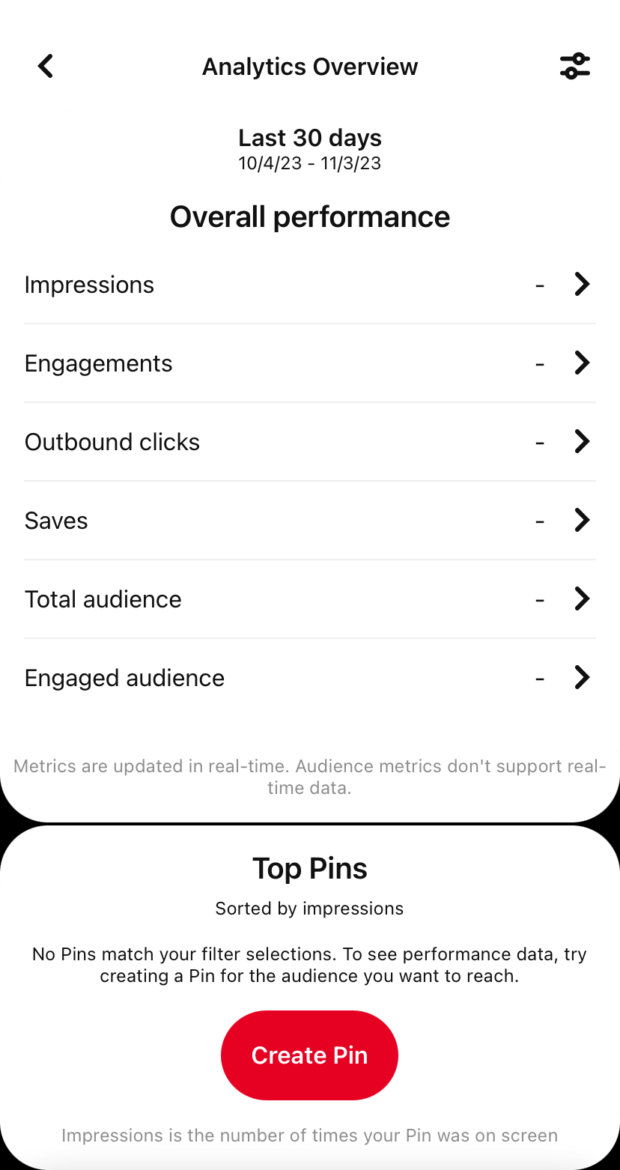
Note: The data Pinterest provides in analytics is an estimate. Some charts need a minimum amount of information to display.
How to access Pinterest analytics using Hootsuite
1. To access Pinterest analytics in Hootsuite, start by logging into your account. (If you don’t have one yet, you can sign up for a free 30-day trial).
2. After you’ve logged in, navigate to the Analytics tab.
3. Once there, you’ll see an overview of your post performance for the date range you select. You can view metrics like engagements, engagement rate, and impressions.
4. In Hootsuite, you can also get insight into the best times to publish your Pins based on when your audience is online and interacting.

If you’re looking for even more data, try Hootsuite Advanced Analytics. You can use it to identify campaigns by performance and pinpoint what may need a paid boost or optimize for better performance.
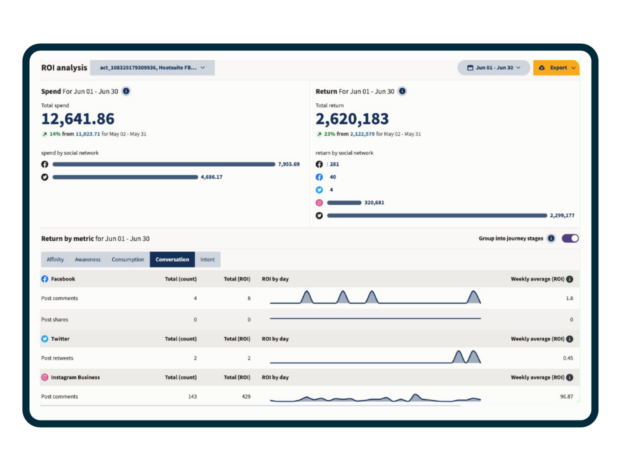
You can also track website visits and ecommerce revenue generated by your Pins. Advanced Analytics helps you understand your Pinterest ROI and plan better campaigns.
16 metrics to track with Pinterest Analytics (and how to read them)
Sure, numbers are fun, but social media networks provide you with analytics for a reason. You won’t understand the value of the platform without a way to track how well your campaigns perform.
If you’re wondering how to see your monthly viewers, how to access Pinterest audience insights, or which Pins are getting the most clicks, that can all be found by tracking these key Pinterest metrics.
Let’s dive into the top metrics to track for Pinterest analytics.
General Pinterest analytics
1. Impressions
What it measures: Impressions measure the number of times your Pins were shown on a user’s screen. Your Pins can appear on the homepage, on another user’s board, or on Pinterest search results. Keep in mind that the same user can log multiple impressions.
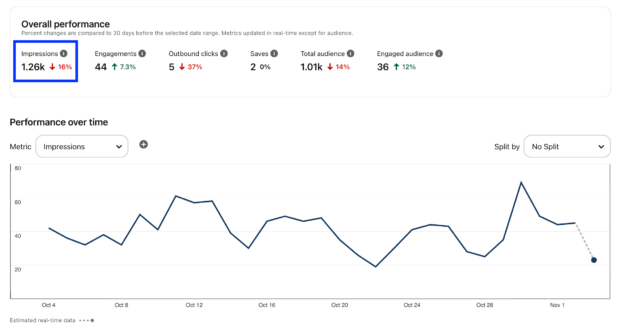
Why it matters: Pinterest impressions tell you how often people see your Pins on the platform (a bit like views!). A high Pin impression rate is a good thing. It says that your content is on-trend or worked well with the Pinterest algorithm — and that your Pinterest SEO strategy is successful.
In addition to tracking your overall Pin impressions, review impressions on your top content. Seeing which Pins are reaching the most people can tell you what content and terms are working well and help you improve future Pins.

2. Engagements
What it measures: Engagement measures the total number of times someone clicked or saved your Pin.
Why it matters: Engagement is everything on social media, and Pinterest is no different. Your Pinterest engagement metrics tell you if your audience has connected with your content. Use this metric with the total audience number to calculate your engagement rate.

3. Outbound clicks
What it measures: Outbound clicks (formerly Link clicks) measure the total number of clicks to the destination URL in your Pin.

Why it matters: Clicks are one of the best ways to measure the effectiveness of your Pinterest strategy. Outbound clicks can tell you if the platform is providing a decent return on investment (ROI).
4. Outbound click rate
What it measures: Outbound click rate is a percentage. It measures the total number of clicks to a Pin’s destination URL, divided by the number of times your Pin was seen.

Why it matters: Measuring outbound click rate gives you a percentage figure to analyze how many of your Pins drive traffic to your website (your ultimate goal!). Outbound click rate will help you gauge the effectiveness of your Pinterest campaigns. A high click-through rate shows that your calls to action are working.
5. Pin clicks
What it measures: Pin clicks (formerly closeups) measure the total number of clicks on your Pin. This number includes clicks that lead to content on and off of Pinterest.
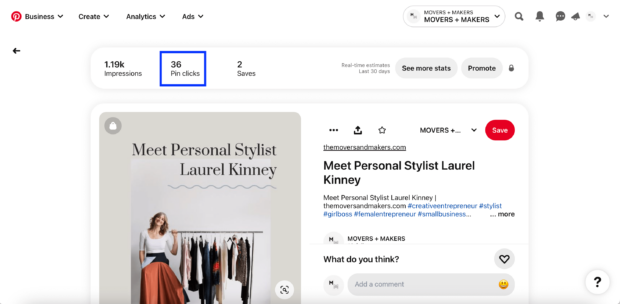
Why it matters: Pin clicks are evidence that something in your Pin caught someone’s eye. To improve your Pin clicks, focus on creating highly visual Pins that match the search intent. This means not only do you need to target the right Pinterest keywords to show up at the top of the search, but your Pins must give users a reason to click on them instead of another one.
For example, if you search “pumpkin pie recipe,” these pins show up at the top of the results. We can assume that they have more Pin clicks than Pins further down the search results.
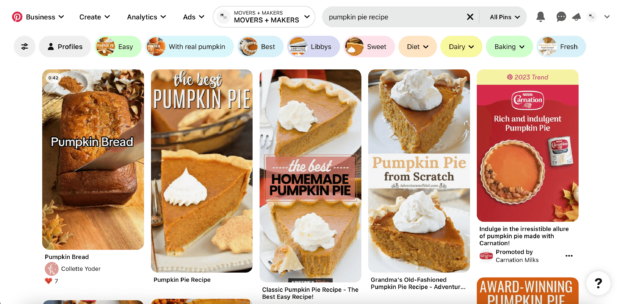
6. Pin click rate
What it measures: Pin click rate is a percentage. It measures the total number of clicks from your Pin to content on or off Pinterest, divided by the number of times your Pin was seen on screen.
Why it matters: A high pin click rate means your audience tends to engage with your content when they see it. It’s a useful measure of how relevant your audience finds your Pins.

7. Saves
What it measures: Saves (formerly known as Repins) are pretty self-explanatory. They tell you how many times someone saved your Pin to one of their boards.
Why it matters: Saves are kind of a big deal. This metric shows how well your Pins and content resonate with your audience.
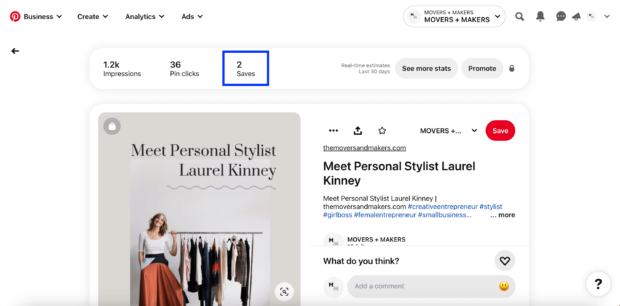
Think of it this way — if they’re saving your Pins, they care about your content. Plus, saved pins net you extra brand exposure since saves also show up on follower feeds. Double win!
8. Total audience
What it measures: Total audience measures the number of unique users who saw your Pin in a given period. You can also view the total monthly audience for a 30-day view of this metric.
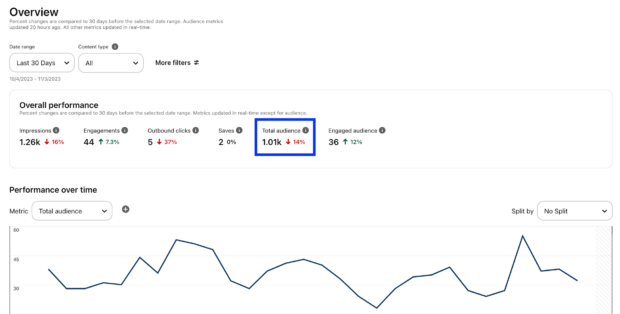
Why it matters: Unlike impressions, the total audience metric tells you how many individuals saw your Pin. This metric can be a better indicator of your actual audience size.
If your impressions are higher than your total audience, it means some people saw your Pin many times. For example, this can happen if a popular Pin is saved to many boards on the platform.
9. Engaged audience
What it measures: Engaged audience measures the number of people who interacted with your Pins during a specific period.
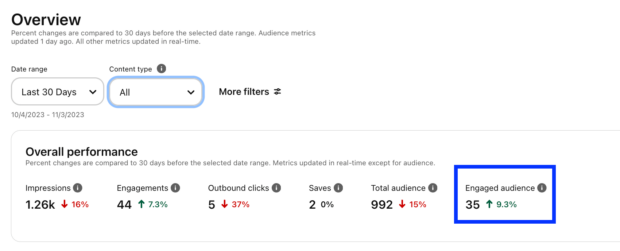
Why it matters: There are several Pinterest engagement metrics because there are so many ways to engage with a Pin. This metric tells you how many people saved, reacted to, commented, or clicked on your Pin. You can use this information to find your top-performing content types.
10. Video views
What it measures: Video views measure the number of video views that last longer than 2 seconds. 50% or more of the video must be in view.
Why it matters: This metric tells you how well your video content manages to hook your audience. Plus, video is one of the hottest social media trends, especially on Pinterest. Nearly one billion people watch videos on Pinterest every day. Incorporating video into your Pinterest strategy positions your brand as forward-thinking.
Beautiful reports. Clear data. Actionable insights to help you grow faster.
Pinterest audience analytics
11. Demographics
What it measures: Pinterest Analytics audience insights cover basic demographics. These include age, gender, location, device stats, and information on categories and interests.
Why it matters: The better you understand your audience, the higher chance you have of creating content they will like. You can use Pinterest demographic data to fine-tune your Pinterest strategy. These stats can help you share region-specific deals or even post in a different language.
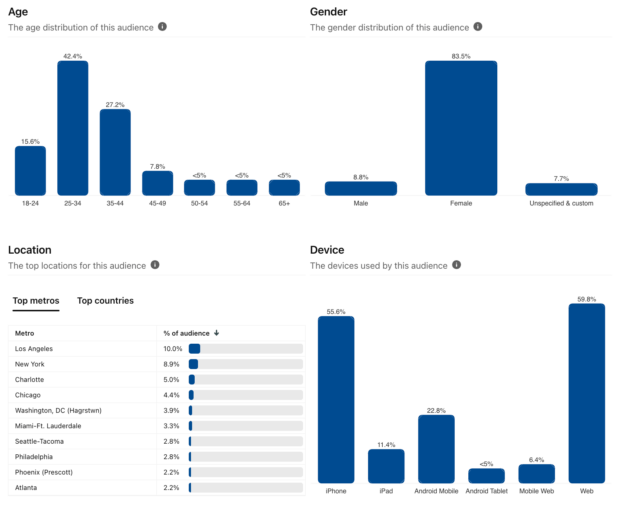
12. Affinity
What it measures: Affinity tells you how much an audience cares about a specific topic compared to the overall Pinterest audience. The higher this percentage, the more likely your audience will engage with this topic. You can track this metric for both your total audience and your engaged audience.

Why it matters: Knowing what your audience likes can be a great source of content inspiration. You can also target specific affinities with Pinterest ad campaigns.
13. Conversion insights
What it measures: Conversion insights measure the impact of organic and paid performance. Here, you’ll find information about return on ad spend (ROAS) and cost per action (CPA).
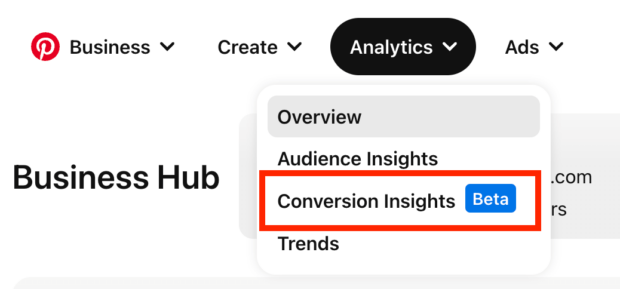
Why it matters: Your organic and paid marketing work together to support a holistic Pinterest strategy. This page helps you review both organic and paid in a single dashboard.
The conversion insights page is available to all advertisers with healthy Pinterest tags.
Note: Conversion insights is currently in open beta, so expect to see some minor adjustments soon.
14. Top converting Pins
What it measures: You can measure your top Pins based on different conversion goals. These goals include impressions, saves, Pin clicks, Page visits, Add to cart, and Checkout. You’ll find this in the Conversions section of Pinterest Analytics.
Why it matters: It’s worth checking how Pins stack up depending on your goals. See if some Pins are better at driving specific actions—if that wasn’t by design, analyze why that may be. If some Pins outperform in every category, you may have stumbled upon a formula for success.
15. Page visits
What it measures: The number of times people visited your website from Pinterest. To track website conversions from Pinterest, you need to claim your site. Doing this helps Pinterest verify your site and connect your analytics.
Why it matters: Keep an eye on this metric if website conversions are one of your objectives. Measure it against Add to cart and Checkout metrics to see if your website is performing.
16. Add to cart and checkouts
What it measures: These two metrics track activity after a Pinterest referral. One measures the number of times people have added items to their cart. The other measures successful purchases.
Why it matters: These metrics should be viewed in tandem with page visits. If page visits are high, but cart and checkout metrics are low, look for ways to optimize website pages. If add to cart numbers are high and checkouts are low, you may need to troubleshoot. Make sure your checkout is working or follow up with customers who abandon their carts.
4 Pinterest analytics tools to help you track your success
Pinterest’s built-in analytics offer a general overview of your performance, but adding these tools to your workflow will help you understand your Pinterest performance even better.
More data can help you drive more engagement, clicks, and conversions. Here are a few Pinterest analytics tools to check out.
1. Hootsuite
Hootsuite helps you compose, assign, publish, and schedule Pins from one central dashboard. You can post Pins all at once, schedule Pins across many boards, or schedule them for later.
Pinterest recommends you post Pins on a weekly basis, so a scheduling tool like Hootsuite can make that a lot easier. If you have a batch of Pins you want to share to keep up your weekly cadence and maintain an active presence, you can use Hootsuite to schedule Pins in advance. You can also create publish-ready Pins using Canva templates directly in Hootsuite Composer, making it even easier to streamline your workflow.
With Hootsuite Advanced Analytics, you can identify campaigns by performance. This helps you pinpoint what may need a paid boost or optimize for better performance. You can also track website visits and ecommerce revenue generated by your Pins. Advanced Analytics helps you understand your Pinterest ROI and plan better campaigns.
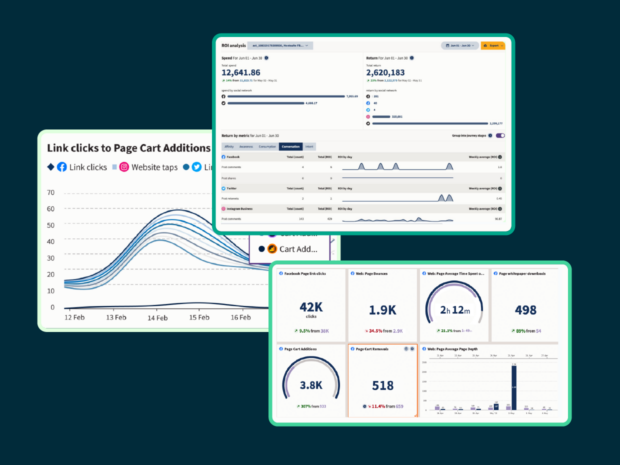
Plus, Hootsuite’s a real time-saver if you’re marketing across multiple social media platforms. You can compare your Pinterest performance alongside other social networks.
2. Pinterest Analytics
Pinterest’s native analytics tool is a good option if you’re looking for data directly within the platform.
If you spend a lot of time manually publishing Pins or scrolling through the home feed for inspiration, it’s easy to pop over to the built-in Analytics tab to get a quick overview of your recent Pinterest performance.
Pinterest Analytics also offers insights into the current trends which can be helpful for brainstorming new content to publish.
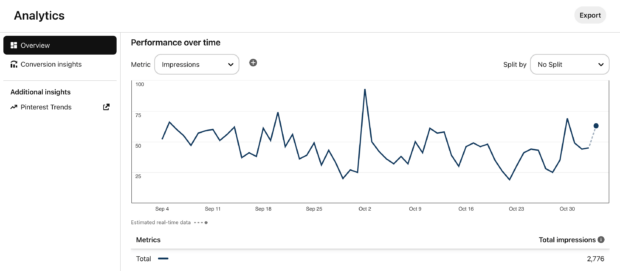
3. Google Analytics
Pinterest is a powerful search engine, so it only makes sense to combine that power with Google. Google Analytics is essential to understand how Pinterest performs against other traffic sources.
To use Google Analytics for Pinterest, start by logging into your Google Analytics account. Then, click on Acquisition, then Social. This will show you how much website traffic comes from each social network.
Google Analytics can also tell you which website pages are the most popular. Use this info to create related Pinterest content.
If you don’t know how to set up your social media dashboards in Google Analytics, check out our 4-step guide.
4. Mentionlytics
Social analytics is often limited to tracking and measuring your performance. But you also need to keep tabs on how other people create and share content about your brand.
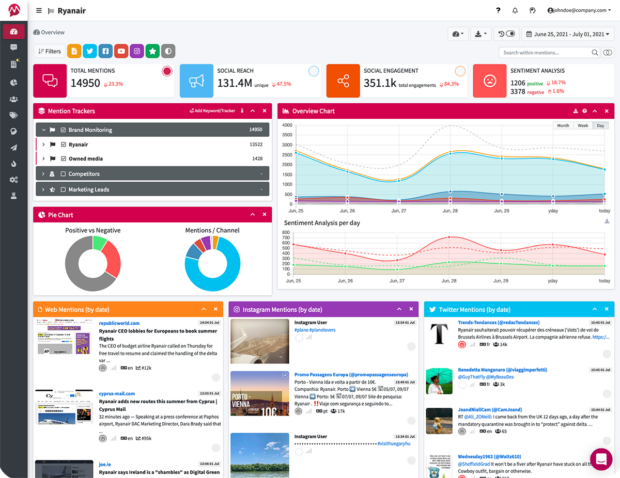
Mentionlytics scans Pinterest for mentions of your brand and displays them in the Hootsuite dashboard. Track sentiment, see what Pins are taking off, and join the conversation.
Save time on Pinterest with Hootsuite. Schedule and publish Pins, create new boards, Pin to multiple boards at once, and run all your other social media profiles — all from one simple dashboard.
Schedule Pins and track their performance alongside your other social networks—all in the same easy-to-use dashboard.
Free 30-Day Trial



